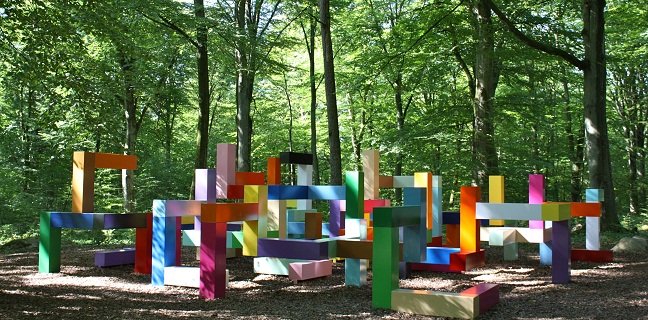
Jacob Dahlgren
(Född/Born 1970, verksam i/works in Stockholm)
Primary Structure, 2011
104 ståldelar i 18 färger/104 steel parts in 18 colours
10 x 10 x 2,5 m
Med stöd från/With support from Hjalmar Wicanders fond, Wanås Konst Artlover
For English please scroll down
Jacob Dahlgrens skulptur breder ut sig under de omgivande bokträdens kronor, 104 delar i 18 färger vilar på ett fundament som mäter 10,5 x 10,5 meter. Dahlgren utgick från en rektangulär form med ett specifikt mått – 27,5 x 27,5 x 110 cm – som han sedan kombinerade. Delarna är uppdelade i sektioner som sitter ihop med varandra och bygger på höjden och längden. Repetition av formen bygger skulpturen, enkel men egensinnig.
Dahlgrens titel är hämtad från en utställning på Jewish Museum i New York 1966, Primary Structures. I den deltog amerikanska och brittiska konstnärer som arbetade med enkla former, ofta i serier. Utställningen fick stor uppmärksamhet och konstnärerna lyftes fram med beteckningen minimalister, som sedan blev ett etablerat begrepp. Dahlgrens formspråk har referenser till minimalismen och även till hur centralt det var för dess konstnärer att undersöka förhållandet mellan kropp och objekt.
För Dahlgren är det viktigt att besökaren till och med blir en del av verket. Han har tidigare arbetat med ett golv av badrumsvågar, som besökaren vägt sig på, eller en vägg av piltavlor, som besökaren förändrat genom att kasta pilar på. När Primary Structure invigdes på vernissagedagen i maj 2011 genomfördes en performance, Our body might not accept central viewpoints. Nära 130 personer klädda i svartvitrandig överdel tog plats på bänkar i parken och bland konstverken. Deras svartvitrandiga klädsel utgjorde en kontrast till den palett av färger som skulpturen utgör, och som en förlängning av hans performance var konsthallspersonalen klädd i svartvitrandigt hela säsongen 2011.
>>>
Jacob Dahlgren’s sculpture spreads out under the branches of the surrounding beech trees; 104 units in 18 colours rest on a foundation measuring 10.5 x 10.5 metres. Jacob Dahlgren began with a rectangular form of specific dimensions—27.5 x 27.5 x 110 cm—which he then combined. The units are divided into sections that link to each other and expand the sculpture vertically and horizontally. The repetition of the form creates the sculpture: simple and complex at the same time.
Dahlgren’s title was taken from an exhibition at the Jewish Museum in New York City in 1966, Primary Structures, which featured American and British artists who worked with simple forms, often in series. The exhibition was highly praised and the artists were dubbed “minimalists,” which later became an established concept. Dahlgren’s idiom contains references to minimalism and its central investigation of the relationship between body and object.
For Dahlgren, it is important that the visitor also becomes part of the artwork. Previously, he created a floor made from bathroom scales on which visitors weighed themselves, as well as a wall of dartboards, which the visitors altered by throwing darts at them. When Primary Structure was inaugurated at the opening in May of 2011, there was also a performance called Our body might not accept central viewpoints. Almost 130 people wearing black-and-white striped tops occupied benches in the park as well as the artworks. Their striped clothing stood in contrast to the palette of colours that comprise the sculpture, and as an extension of his performance, the gallery staff wore black and white stripes for the entire 2011 season.